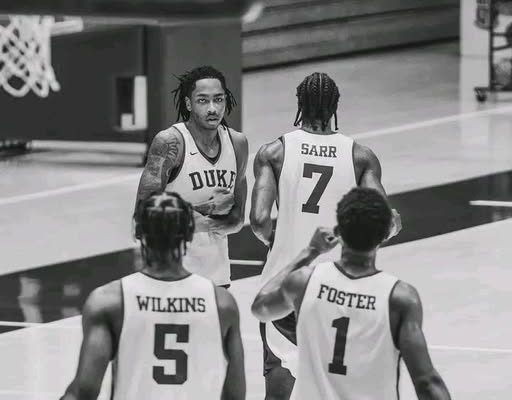The Blue Devils have always been synonymous with basketball excellence. From the days of Coach K crafting perennial Final Four contenders to the new era under Jon Scheyer, Duke University basketball has carried a tradition of fierce competition, elite talent, and relentless internal drive. But what’s brewing in Durham this offseason is different. Something feels more competitive. Tighter. Sharper. And after months of offseason buzz, insider reports, and most importantly, eyes-on-the-ground practice sessions, one thing has become increasingly clear: this might be the deepest Duke roster the program has had in years — maybe even a decade.
This isn’t just speculation. This is coming straight from those who have seen the five-on-five battles behind closed doors. In the practice gym, iron is sharpening iron every day. From experienced returners to highly-rated freshmen and underrated bench pieces eager to prove themselves, every player is in a fight for minutes. Nobody’s safe, and that’s precisely how Jon Scheyer wants it.
Scheyer, now entering his third year as Duke’s head coach, has steadily begun putting his own fingerprint on the program. While the shadow of Mike Krzyzewski still hovers over Cameron Indoor Stadium, Scheyer hasn’t tried to copy and paste. Instead, he’s blended Duke’s storied identity with a new culture of intensity and depth. That culture is culminating in one of the most balanced, flexible, and stacked lineups Duke has had in recent memory.
What makes this roster so fascinating isn’t just the talent — Duke has had loads of that before. It’s the mix. For once, the Blue Devils don’t need to lean heavily on a single phenom or class of one-and-done prospects. Instead, they’ve got legitimate rotational pieces across every position, with players who can both star and sacrifice. And Scheyer has made it clear: reputation doesn’t guarantee anything. If you want to start, you’ve got to earn it on the hardwood.
Leading the way are the veterans — players who have seen the rigors of ACC play and know what March basketball demands. Tyrese Proctor, who decided to come back for another year, is the embodiment of that decision paying off. A highly skilled guard with NBA-level tools, Proctor has used his time at Duke to build a more complete game. He’s no longer just a skilled distributor or pull-up shooter. His voice now commands respect in the locker room. He defends at a higher level. He sets the tone during scrimmages. But he’s also not alone.
Mark Mitchell has transformed over the summer, both physically and mentally. Once more of a slashing wing, he’s expanded his shot profile and become a far more confident playmaker. He’s had to, because the pressure coming from younger players has been relentless. Every day in practice, Mitchell finds himself matched up against some of the best freshman forwards in the country, forcing him to level up or get left behind.
The return of Kyle Filipowski — the team’s top scorer and arguably its most NBA-ready talent — was a surprise to many. After a strong freshman campaign, most assumed he’d be gone. But his decision to stay has altered the landscape for Duke. It’s not just about stats with Filipowski. It’s the leadership. The floor spacing. The ability to anchor a defense while running offensive sets through him. But even he’s not immune to competition.
That’s because this incoming freshman class, while maybe not the top-ranked group in the country, is built different. These are not players coming in with a mindset to coast or blend in. They came to Durham to take spots, win championships, and raise their draft stock in the process.
Freshman forward Isaiah Evans has turned heads early. He’s wiry, aggressive, and fearless — the type of player who doesn’t wait for permission to take over a possession. Then there’s Kon Knueppel, the sharpshooter out of Wisconsin, who has already become one of the most reliable perimeter threats on the team. He’s deceptively strong, patient with his movements, and never seems rushed. Scheyer has praised his court IQ more than once this summer.
Perhaps the most buzz, though, surrounds big man Khaman Maluach, the South Sudanese phenom who joined late but hasn’t wasted time making an impression. Towering at 7-foot-2 with a developing touch and elite shot-blocking instincts, Maluach is already giving Duke’s returning bigs all they can handle in scrimmage settings. One coach reportedly said Maluach’s presence “changes the geometry of the court.” You don’t say that about many 18-year-olds.
All of this competition has led to an unexpected byproduct: elevated intensity. Practices aren’t just practices anymore — they’re battlegrounds. Rotations change daily. One player dominates Tuesday’s scrimmage, only to find themselves humbled on Thursday. Coaches love it. The players, while exhausted, know it’s sharpening them. And for the first time in years, Duke might not need to rely on just six or seven contributors come March.
That’s not to say the team doesn’t still have questions to answer. Depth is great on paper, but it brings challenges. How do you keep a roster full of stars and future pros happy when some will inevitably play limited roles? Can the locker room stay unified when minutes don’t match expectations? These are the dynamics that often undo talented teams before the postseason even arrives.
But Scheyer has embraced that reality. He’s made it clear since summer workouts began: nobody is above competition. Reputation, recruiting ranking, NIL earnings — none of that earns you time on the floor. It’s earned in drills, in defense, in rebounding, in communication. It’s earned in how you handle adversity and whether you lift teammates up when you’re the one coming off the bench.
Perhaps the most exciting thing for Duke fans is how this depth will allow the team to play different styles. Want to run small and space the floor? You’ve got guards like Caleb Foster, a second-year player ready to explode, and shooters like Jared McCain ready to light it up from deep. Want to go big and physical? You can pair Filipowski with Maluach and throw Mitchell on the wing for matchup nightmares. Want to press, switch, and create chaos defensively? There are at least six guys on the roster with the length and lateral quickness to do just that.
In short, Duke is no longer boxed into one identity. This is a roster that can adapt. It can survive foul trouble, injuries, cold shooting nights. That’s what wins in March and April. It’s not just star power — it’s flexibility. It’s resilience. And if early practices are any indication, Duke has both in spades this year.
There’s also something else brewing in Durham — a chip. Maybe it’s the sting of last season’s Sweet 16 disappointment. Maybe it’s the media’s focus on other blue-bloods or the growing dominance of the transfer portal elsewhere. But within the program, there’s a sense that this Duke team is being slept on. And they like it that way. They’re leaning into the underdog narrative, even if the name on the jersey suggests otherwise.
For a program that’s often been the hunted, this might be the first time in a while they’ve felt like hunters. And that mindset, when combined with depth and internal competition, is dangerous.
Of course, the season is still months away. Preseason hype doesn’t win games. But what’s happening in these summer practices isn’t fluff. It’s not just coach-speak. The energy is different. The leadership is stronger. The battles are tighter. And the floor, as one assistant coach noted, “feels more crowded with talent than I’ve seen in a long time.”
The Blue Devils won’t have an easy road. The ACC remains competitive, and non-conference battles with teams like Kansas and Arizona loom large. But what they’re building — in private, away from the spotlight — has the makings of something special.
Jon Scheyer knows what a championship roster feels like. He played on one. He’s coached on one. And quietly, behind the doors of the Duke practice facility, he might just be shaping the next one.
Because when nobody’s safe, and everybody’s hungry, the ceiling only gets higher. And for this 2025 Duke team, that ceiling might just be cutting nets again in April.



